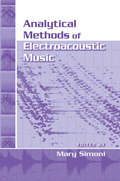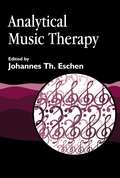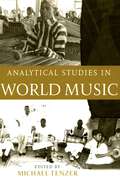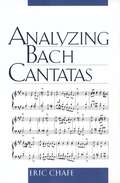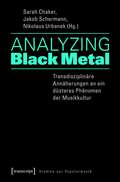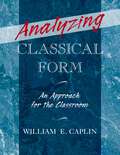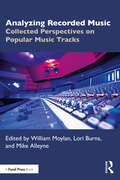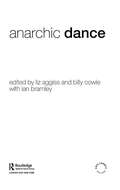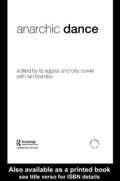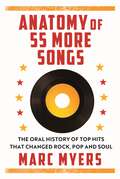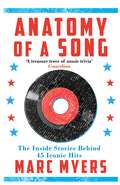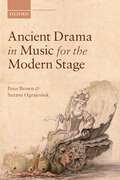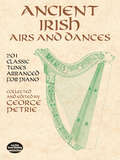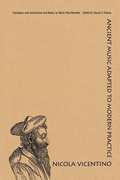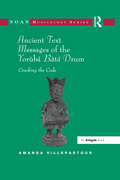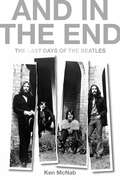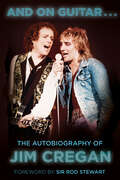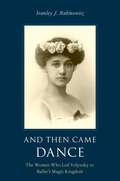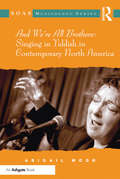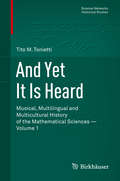- Table View
- List View
Analytical Methods of Electroacoustic Music
by Mary SimoniContaining extensive artwork serving as demonstration, as well as a DVD with sound and video clips, this collection of essays on electroacoustic music explores the creative possibilities to be found in various forms of musical analysis. Taking pitch, duration, intensity, and timbre as the four basic elements of music, the authors discuss electroacoustic works and examine: * the applications of neumes* contemporary staff notation* sound orchestra and score files* time-domain representations* spectrograms. Taking into consideration both the positive aspects (preservation of the abstract) and negative aspects (creative limitation) of these analytical methods, the authors have created a useful resource for students of electroacoustic music.
Analytical Music Therapy (PDF)
by Johannes Eschen Juliane Kowski Susan HadleyThis book brings together the professional experiences of eminent analytical music therapists from Europe and the USA. The book examines the origins and theory of AMT (including a contribution on the subject from Mary Priestley), before exploring its uses in various contexts. Chapters cover AMT in counselling and rehabilitation, with adults and children and with nonverbal clients. A concluding section discusses aspects of the training of music therapy students. Written by experienced and highly regarded analytic music therapists, and edited by Johannes Th. Eschen, one of the first ever AMT students, this book will be of interest to practitioners in many branches of music therapy and related disciplines.
Analytical Studies in World Music
Combining the approaches of ethnomusicology and music theory, Analytical Studies in World Music offers fresh perspectives for thinking about how musical sounds are shaped, arranged, and composed by their diverse makers worldwide. Eleven inspired, insightful, and in-depth explanations of Iranian sung poetry, Javanese and Balinese gamelan music, Afro-Cuban drumming, flamenco, modern American chamber music, and a wealth of other genres create a border-erasing compendium of ingenious music analyses. Selections on the companion website are carefully matched with extensive transcriptions and illuminating diagrams in every chapter. Opening rich cross-cultural perspectives on music, this volume addresses the practical needs of students and scholars in the contemporary world of fusions, contact, borrowing, and curiosity about music everywhere.
Analyzing Bach Cantatas
by Eric ChafeBach's cantatas are among the highest achievements of Western musical art, yet studies of the individual cantatas that are both illuminating and detailed are few. In this book, noted Bach expert Eric Chafe combines theological, historical, analytical, and interpretive approaches to the cantatas to offer readers and listeners alike the richest possible experience of these works. A respected theorist of seventeenth-century music, Chafe is sensitive to the composer's intentions and to the enduring and universal qualities of the music itself. Concentrating on a small number of representative cantatas, mostly from the Leipzig cycles of 1723-24 and 1724-25, and in particular on Cantata 77, Chafe shows how Bach strove to mirror both the dogma and the mystery of religious experience in musical allegory. Analyzing Bach Cantatas offers valuable information on the theological relevance of the structure of the liturgical year for the design and content of these works, as well as a survey of the theories of modality that inform Bach's compositional style. Chafe demonstrates that, while Bach certainly employed "pictorialism" and word-painting in his compositions, his method of writing music was a more complex amalgam of theological concepts and music theory. Regarding the cantatas as musical allegories that reflect the fundamental tenets of Lutheran theology as established during Bach's lifetime, Chafe synthesizes a number of key musical and theological ideas to illuminate the essential character of these great works. This unique and insightful book offers an essential methodology for understanding one of the central bodies of work in the Western musical canon. It will prove indispensable for all students and scholars of Bach's work, musicology, and theological studies.
Analyzing Bach Cantatas
by Eric ChafeBach's cantatas are among the highest achievements of Western musical art, yet studies of the individual cantatas that are both illuminating and detailed are few. In this book, noted Bach expert Eric Chafe combines theological, historical, analytical, and interpretive approaches to the cantatas to offer readers and listeners alike the richest possible experience of these works. A respected theorist of seventeenth-century music, Chafe is sensitive to the composer's intentions and to the enduring and universal qualities of the music itself. Concentrating on a small number of representative cantatas, mostly from the Leipzig cycles of 1723-24 and 1724-25, and in particular on Cantata 77, Chafe shows how Bach strove to mirror both the dogma and the mystery of religious experience in musical allegory. Analyzing Bach Cantatas offers valuable information on the theological relevance of the structure of the liturgical year for the design and content of these works, as well as a survey of the theories of modality that inform Bach's compositional style. Chafe demonstrates that, while Bach certainly employed "pictorialism" and word-painting in his compositions, his method of writing music was a more complex amalgam of theological concepts and music theory. Regarding the cantatas as musical allegories that reflect the fundamental tenets of Lutheran theology as established during Bach's lifetime, Chafe synthesizes a number of key musical and theological ideas to illuminate the essential character of these great works. This unique and insightful book offers an essential methodology for understanding one of the central bodies of work in the Western musical canon. It will prove indispensable for all students and scholars of Bach's work, musicology, and theological studies.
Analyzing Black Metal - Transdisziplinäre Annäherungen an ein düsteres Phänomen der Musikkultur (Studien zur Popularmusik)
by Sarah Chaker Jakob Schermann Nikolaus UrbanekTiefschwarze Nächte, Krächzgesang und Kunstblut, magische Symbole, archaische Rituale und uralte Geschichten: Black Metal bedient auf unterschiedlichsten Ebenen der Inszenierung Codes des Dunklen, Bösen und Geheimnisvollen - musikalisch-klanglich, diskursiv, visuell, körperlich-performativ, paratextuell. Doch wie genau funktionieren gängige ästhetische Symbole des Black Metal und wie sind sie in ihrem jeweiligen Kontext zu verstehen und einzuordnen? Ausgehend von dieser Frage bieten die Beiträge des Bandes differenzierte Einblicke in ein komplexes musikalisches und kulturelles Gegenwartsphänomen. Darüber hinaus geben sie methodisch Aufschluss über Möglichkeiten und Grenzen transdisziplinärer, kollektiver Analysen von populärer Musik.
Analyzing Classical Form: An Approach for the Classroom
by William E. CaplinAnalyzing Classical Form builds upon the foundations of the author's critically acclaimed Classical Form by offering an approach to the analysis of musical form that is especially suited for classroom use. Providing ample material for study in both undergraduate and graduate courses, Analyzing Classical Form presents the most up-to-date version of the author's "theory of formal functions." Students will learn how to make complete harmonic and formal analyses of music drawn from the instrumental works of Haydn, Mozart, and Beethoven. Part 1 introduces the principal theme-types of classical instrumental music; part 2 provides a methodology for analyzing sonata form, the most important formal type in this style period; and part 3 considers other full-movement forms found in this repertory (such as minuet, rondo, and concerto). The chapters are organized in a way that presents the most basic materials upfront and then leads the student through more details and finer points of theory. Every topic is illustrated with annotated musical examples; as well, the book contains many unannotated examples that can be used for in-class discussion and for out-of-class analytical exercises. A complete glossary of terms and questions for reviewing the theory will help students assimilate the many theoretical concepts employed in the book. A companion website hosted by the author at music.mcgill.ca/acf/ provides audio and musical scores for all of the examples in the book as well as additional examples for the analysis of the simple theme-types presented in part 1.
Analyzing Recorded Music: Collected Perspectives on Popular Music Tracks
by William Moylan Lori Burns Mike AlleyneAnalyzing Recorded Music: Collected Perspectives on Popular Music Tracks is a collection of essays dedicated to the study of recorded popular music, with the aim of exploring "how the record shapes the song" (Moylan, Recording Analysis, 2020) from a variety of perspectives. Introduced with a Foreword by Paul Théberge, the distinguished editorial team has brought together a group of reputable international contributors to write about a rich collection of recordings. Examining a diverse set of songs from a range of genres and points in history (spanning the years 1936–2020), the authors herein illuminate unique attributes of the selected tracks and reveal how the recording develops the expressive content of song performance. Analyzing Recorded Music will interest all those who study popular music, cultural studies, and the musicology of record production, as well as to popular music listeners.
Analyzing Recorded Music: Collected Perspectives on Popular Music Tracks
by William Moylan Lori Burns Mike AlleyneAnalyzing Recorded Music: Collected Perspectives on Popular Music Tracks is a collection of essays dedicated to the study of recorded popular music, with the aim of exploring "how the record shapes the song" (Moylan, Recording Analysis, 2020) from a variety of perspectives. Introduced with a Foreword by Paul Théberge, the distinguished editorial team has brought together a group of reputable international contributors to write about a rich collection of recordings. Examining a diverse set of songs from a range of genres and points in history (spanning the years 1936–2020), the authors herein illuminate unique attributes of the selected tracks and reveal how the recording develops the expressive content of song performance. Analyzing Recorded Music will interest all those who study popular music, cultural studies, and the musicology of record production, as well as to popular music listeners.
Anarchic Dance
by Liz Aggiss Billy CowieLiz Aggiss and Billy Cowie, known collectively as Divas Dance Theatre, are renowned for their highly visual, interdisciplinary brand of dance performance that incorporates elements of theatre, film, opera, poetry and vaudevillian humour. Anarchic Dance, consisting of a book and DVD-Rom, is a visual and textual record of their boundary-shattering performance work. The DVD-Rom features extracts from Aggiss and Cowie's work, including the highly-acclaimed dance film Motion Control (premiered on BBC2 in 2002), rare video footage of their punk-comic live performances as The Wild Wigglers and reconstructions of Aggiss's solo performance in Grotesque Dancer. These films are cross-referenced in the book, allowing readers to match performance and commentary as Aggiss and Cowie invite a broad range of writers to examine their live performance and dance screen practice through analysis, theory, discussion and personal response. Extensively illustrated with black and white and colour photographs Anarchic Dance, provides a comprehensive investigation into Cowie and Aggiss’s collaborative partnership and demonstrates a range of exciting approaches through which dance performance can be engaged critically.
Anarchic Dance
by Liz Aggiss Billy Cowie Ian BramleyLiz Aggiss and Billy Cowie, known collectively as Divas Dance Theatre, are renowned for their highly visual, interdisciplinary brand of dance performance that incorporates elements of theatre, film, opera, poetry and vaudevillian humour. Anarchic Dance, consisting of a book and DVD-Rom, is a visual and textual record of their boundary-shattering performance work. The DVD-Rom features extracts from Aggiss and Cowie's work, including the highly-acclaimed dance film Motion Control (premiered on BBC2 in 2002), rare video footage of their punk-comic live performances as The Wild Wigglers and reconstructions of Aggiss's solo performance in Grotesque Dancer. These films are cross-referenced in the book, allowing readers to match performance and commentary as Aggiss and Cowie invite a broad range of writers to examine their live performance and dance screen practice through analysis, theory, discussion and personal response. Extensively illustrated with black and white and colour photographs Anarchic Dance, provides a comprehensive investigation into Cowie and Aggiss’s collaborative partnership and demonstrates a range of exciting approaches through which dance performance can be engaged critically.
Anatomy of 55 More Songs: The Oral History of 55 Hits That Changed Rock, R&B and Soul
by Marc MyersSongs that sell the most copies become hits, but some of those hits become something more - iconic recordings that not only inspire a generation but also alter the direction of music. In this follow-up to his classic Anatomy of a Song, writer and music historian Marc Myers tells the stories behind fifty-five more rock, pop, R&B, country and reggae hits through intimate interviews with the artists who wrote and recorded them.Part oral history, part musical analysis, Anatomy of 55 More Songs ranges from Creedence Clearwater Revival's 'Bad Moon Rising' to Dionne Warwick's 'Walk On By', The Beach Boys' 'Good Vibrations' and Black Sabbath's 'Paranoid'. Bernie Taupin recalls how he wrote the lyrics to Elton John's 'Rocket Man'; Joan Jett remembers channeling her rage against how she had been unfairly labeled and treated into 'Bad Reputation' and Ozzy Osbourne, Elvis Costello, Bob Weir, Sheryl Crow, Alice Cooper, Roberta Flack, John Mellencamp, Keith Richards, Carly Simon and many others reveal the emotions and technique behind their major works.
Anatomy of a Song: The Inside Stories Behind 45 Iconic Hits
by Marc MyersSongs that sell the most copies become hits, but some of those hits transcend commercial value, touching a generation of listeners and altering the direction of music. In Anatomy of a Song, writer and music historian Marc Myers tells the stories behind fifty rock, pop, R&B, country and reggae hits through intimate interviews with the artists who wrote and recorded them.Mick Jagger, Jimmy Page, the Clash, Smokey Robinson, Grace Slick, Roger Waters, Joni Mitchell, Steven Tyler, Rod Stewart, Elvis Costello and many other leading artists reveal the inspirations, struggles and techniques behind their influential works.
Ancient Drama in Music for the Modern Stage
by Peter BrownOpera was invented at the end of the sixteenth century in imitation of the supposed style of delivery of ancient Greek tragedy, and, since then, operas based on Greek drama have been among the most important in the repertoire. This collection of essays by leading authorities in the fields of Classics, Musicology, Dance Studies, English Literature, Modern Languages, and Theatre Studies provides an exceptionally wide-ranging and detailed overview of the relationship between the two genres. Since tragedies have played a much larger part than comedies in this branch of operatic history, the volume mostly concentrates on the tragic repertoire, but a chapter on musical versions of Aristophanes' Lysistrata is included, as well as discussions of incidental music, a very important part of the musical reception of ancient drama, from Andrea Gabrieli in 1585 to Harrison Birtwistle and Judith Weir in the late twentieth and early twenty-first centuries.
Ancient Irish Airs and Dances: 201 Classic Tunes Arranged for Piano
by George PetrieFrom the tender "My heart's love is he" to the bitter "Hag, you've killed me," this extraordinary compilation of melodies ranks among the most important 19th-century collections of traditional Irish music. Out of print for many years, these selections have become extremely rare and sought-after items.
Ancient Music Adapted to Modern Practice (Music Theory Translation Ser.)
by Nicola Vicentino Maria Maniates Claude PaliscaFirst published in Rome in 1555, Nicola Vicentino's treatise was one of the most influential music theory texts of the sixteenth century. This translation by Maria Rika Maniates is the first English-language edition of Vicentino's important work. Unlike most early theorists, Vicentino did not simply summarize the practice of his time. His aim was to change how composers wrote and how musicians thought about music. His best-known contribution is the adaptation of the ancient Greek chromatic and enharmonic genera to modern polyphonic practice. But he also expressed the avant garde's position on the relation between music and the subject matter and feelings of a secular or sacred text. He challenged the view that part-writing had always to conform to the rules of counterpoint, asserting that license was permissible in order to express the feelings of a verbal text. In this he anticipated the manifestos of Vincenzo Galilei and Claudio Monteverdi. Maniates' introduction discusses Vicentino's life and work, the sources of his ideas in earlier theoretical literature, and the contemporary humanists from whom he may have learned.
Ancient Text Messages of the Yoruba Bata Drum: Cracking the Code (SOAS Studies in Music)
by Amanda VillepastourThe bata is one of the most important and representative percussion traditions of the people in southwest Nigeria, and is now learnt and performed around the world. In Cuba, their own bata tradition derives from the Yoruba bata from Africa yet has had far more research attention than its African predecessor. Although the bata is one of the oldest known Yoruba drumming traditions, the drum and its unique language are now unfamiliar to many contemporary Yoruba people. Amanda Villepastour provides the first academic study of the bata's communication technology and the elaborate coded spoken language of bata drummers, which they refer to as 'ena bata'. Villepastour explains how the bata drummers' speech encoding method links into universal linguistic properties, unknown to the musicians themselves. The analysis draws the direct links between what is spoken in Yoruba, how Yoruba is transformed in to the coded language (ena), how ena prescribes the drum strokes and, finally, how listeners (and which listeners) extract linguistic meaning from what is drummed. The description and analysis of this unique musical system adds substantially to what is known about bata drumming specifically, Yoruba drumming generally, speech surrogacy in music and coded systems of speaking. This book will appeal not only to ethnomusicologists and anthropologists, but also to linguists, drummers and those interested in African Studies.
Ancient Text Messages of the Yoruba Bata Drum: Cracking the Code (SOAS Studies in Music)
by Amanda VillepastourThe bata is one of the most important and representative percussion traditions of the people in southwest Nigeria, and is now learnt and performed around the world. In Cuba, their own bata tradition derives from the Yoruba bata from Africa yet has had far more research attention than its African predecessor. Although the bata is one of the oldest known Yoruba drumming traditions, the drum and its unique language are now unfamiliar to many contemporary Yoruba people. Amanda Villepastour provides the first academic study of the bata's communication technology and the elaborate coded spoken language of bata drummers, which they refer to as 'ena bata'. Villepastour explains how the bata drummers' speech encoding method links into universal linguistic properties, unknown to the musicians themselves. The analysis draws the direct links between what is spoken in Yoruba, how Yoruba is transformed in to the coded language (ena), how ena prescribes the drum strokes and, finally, how listeners (and which listeners) extract linguistic meaning from what is drummed. The description and analysis of this unique musical system adds substantially to what is known about bata drumming specifically, Yoruba drumming generally, speech surrogacy in music and coded systems of speaking. This book will appeal not only to ethnomusicologists and anthropologists, but also to linguists, drummers and those interested in African Studies.
And in the End: The Last Days of The Beatles
by Ken McNabThis is the story of the last acrimonious days of The Beatles, a final chapter reconstructing for the first time the seismic events of 1969, the year that saw the band reach new highs of musical creativity and new lows of internal strife. Two years after Flower Power and the hippie idealism of the Summer of Love, the Sixties dream had perished on the vine. By 1969, violence and vindictiveness had replaced The Beatles’ own mantra of peace and love, and Vietnam and the Cold War had supplanted hope and optimism. And just as the decade foundered on the altar of a cold, harsh reality, so too did The Beatles.In the midst of this rancour, however, emerged the disharmony of Let It Be and the ragged genius of Abbey Road, their incredible farewell love letter to the world.
And on Guitar...: The Autobiography of Jim Cregan
by Andy Merriman Jim CreganJIM CREGAN’s career as a rock guitarist, songwriter and producer has spanned over fifty years, touring and recording albums with stars such as Elton John, Cat Stevens, Family, Willie Nelson, Steve Harley and Cockney Rebel, Joe Cocker, The Gypsy Kings, and Katie Melua, among many others. However, he is perhaps best known for his forty-year association with Rod Stewart, not only as his guitarist but also as best friends and godfathers to each other’s children. In his autobiography Jim Cregan lifts the lid on his extraordinary life, recounting his experiences with music’s biggest stars, from his first band at the age of 14 playing in youth clubs in Poole to performing in front of 350,000 people in Rio de Janeiro. In And on Guitar . . . nothing is held back: Cregan’s early life and anecdotes about his family, shenanigans on the road, extraordinary tales of hedonism, love and loss, his stories feature a Who’s Who of music’s biggest stars.
And Then Came Dance: The Women Who Led Volynsky to Ballet's Magic Kingdom
Presenting for the first time Akim Volynsky's (1861-1926) pre-balletic writings on Leonardo da Vinci, Fyodor Dostoevsky, Otto Weininger, and on such illustrious personalities as Zinaida Gippius, Ida Rubinstein, and Lou Andreas-Salome, And Then Came Dance provides new insight into the origins of Volynsky's life-altering journey to become Russia's foremost ballet critic. A man for whom the realm of art was largely female in form and whose all-encompassing image of woman constituted the crux of his aesthetic contemplation that crossed over into the personal and libidinal, Volynsky looks ahead to another Petersburg-bred high priest of classical dance, George Balanchine. With an undeniable proclivity toward ballet's female component, Volynsky's dance writings, illuminated by examples of his earlier gendered criticism, invite speculation on how truly ground-breaking and forward-looking this critic is.
AND THEN CAME DANCE C: The Women Who Led Volynsky to Ballet's Magic Kingdom
by Stanley J. RabinowitzPresenting for the first time Akim Volynsky's (1861-1926) pre-balletic writings on Leonardo da Vinci, Fyodor Dostoevsky, Otto Weininger, and on such illustrious personalities as Zinaida Gippius, Ida Rubinstein, and Lou Andreas-Salome, And Then Came Dance provides new insight into the origins of Volynsky's life-altering journey to become Russia's foremost ballet critic. A man for whom the realm of art was largely female in form and whose all-encompassing image of woman constituted the crux of his aesthetic contemplation that crossed over into the personal and libidinal, Volynsky looks ahead to another Petersburg-bred high priest of classical dance, George Balanchine. With an undeniable proclivity toward ballet's female component, Volynsky's dance writings, illuminated by examples of his earlier gendered criticism, invite speculation on how truly ground-breaking and forward-looking this critic is.
And We're All Brothers: Singing in Yiddish in Contemporary North America (SOAS Studies in Music)
by Abigail WoodThe dawn of the twenty-first century marked a turning period for American Yiddish culture. The 'Old World' of Yiddish-speaking Eastern Europe was fading from living memory - yet at the same time, Yiddish song enjoyed a renaissance of creative interest, both among a younger generation seeking reengagement with the Yiddish language, and, most prominently via the transnational revival of klezmer music. The last quarter of the twentieth century and the early years of the twenty-first saw a steady stream of new songbook publications and recordings in Yiddish - newly composed songs, well-known singers performing nostalgic favourites, American popular songs translated into Yiddish, theatre songs, and even a couple of forays into Yiddish hip hop; musicians meanwhile engaged with discourses of musical revival, post-Holocaust cultural politics, the transformation of language use, radical alterity and a new generation of American Jewish identities. This book explores how Yiddish song became such a potent medium for musical and ideological creativity at the twilight of the twentieth century, presenting an episode in the flowing timeline of a musical repertory - New York at the dawn of the twenty-first century - and outlining some of the trajectories that Yiddish song and its singers have taken to, and beyond, this point.
And We're All Brothers: Singing in Yiddish in Contemporary North America (SOAS Studies in Music)
by Abigail WoodThe dawn of the twenty-first century marked a turning period for American Yiddish culture. The 'Old World' of Yiddish-speaking Eastern Europe was fading from living memory - yet at the same time, Yiddish song enjoyed a renaissance of creative interest, both among a younger generation seeking reengagement with the Yiddish language, and, most prominently via the transnational revival of klezmer music. The last quarter of the twentieth century and the early years of the twenty-first saw a steady stream of new songbook publications and recordings in Yiddish - newly composed songs, well-known singers performing nostalgic favourites, American popular songs translated into Yiddish, theatre songs, and even a couple of forays into Yiddish hip hop; musicians meanwhile engaged with discourses of musical revival, post-Holocaust cultural politics, the transformation of language use, radical alterity and a new generation of American Jewish identities. This book explores how Yiddish song became such a potent medium for musical and ideological creativity at the twilight of the twentieth century, presenting an episode in the flowing timeline of a musical repertory - New York at the dawn of the twenty-first century - and outlining some of the trajectories that Yiddish song and its singers have taken to, and beyond, this point.
And Yet It Is Heard: Musical, Multilingual and Multicultural History of the Mathematical Sciences - Volume 1 (Science Networks. Historical Studies #46)
by Tito M. ToniettiWe bring into full light some excerpts on musical subjects which were until now scattered throughout the most famous scientific texts. The main scientific and musical cultures outside of Europe are also taken into consideration. The first and most important property to underline in the scientific texts examined here is the language they are written in. This means that our multicultural history of the sciences necessarily also becomes a review of the various dominant languages used in the different historical contexts. In this volume, the history of the development of the sciences is told as it happened in real contexts, not in an alienated ideal world.
